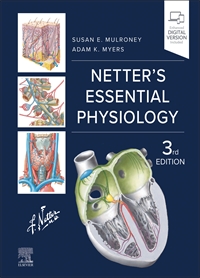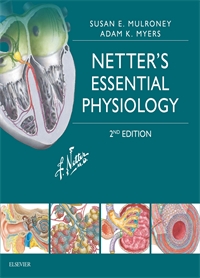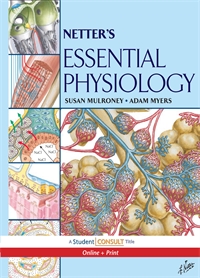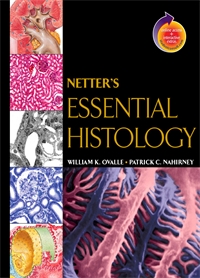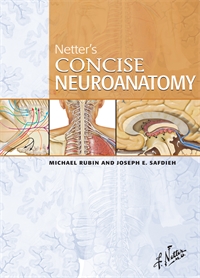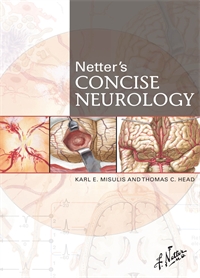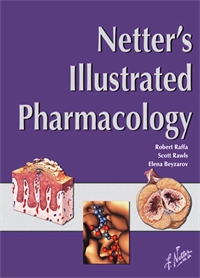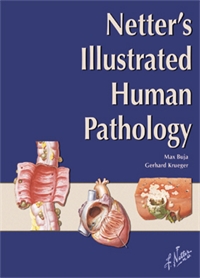Flash Cards - Physiology, Mulroney 1E
Author: Susan Mulroney, Adam Myers
ISBN: 9781416046288
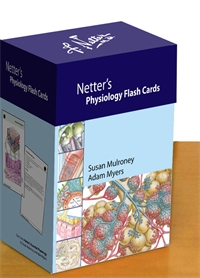
- Page 1.01: Membrane Proteins
- Page 1.02: Body Fluid Compartments
- Page 1.03: Measurement of Fluid Compartments
- Page 1.04: Starling Forces Across the Capillary Wall
- Page 1.05: Fluid Balance
- Page 1.06: Cellular Transport I: Active Transport
- Page 1.07: Cellular Transport II: Gated Channels
- Page 1.08: Cellular Transport III: Solute Movement
- Page 1.09: Cellular Transport IV: Vesicular Transport
- Page 1.1: Cellular Transport V: Water Channels
- Page 1.11: Signal Transduction I: CA2+
- Page 1.12: Signal Transduction II: G-Protein-Coupled Receptors
- Page 1.13: Signal Transduction III: Receptor Tyrosine Kinase Pathway
- Page 1.14: Signal Transduction IV: Nuclear Protein Receptors
- Page 2.01: Nernst Potential
- Page 2.02: Resting Membrane Potential
- Page 2.03: Axonal Action Potential
- Page 2.04: Neurons
- Page 2.05: Axonal Conduction
- Page 2.06: Morphology of Synapses
- Page 2.07: Chemical Synaptic Transmission
- Page 2.08: Structure of Neuromuscular Junction
- Page 2.09: Sarcoplasmic Reticulum
- Page 2.1: Excitation-Contraction Coupling
- Page 2.11: Skeletal Muscle Contraction and Relaxation
- Page 2.12: Biochemical Mechanics of Muscle Contraction
- Page 2.13: Excitation-Contraction Coupling of Smooth Muscle
- Page 2.14: Cardiac Muscle Structure
- Page 2.15: Major Parts of the Central Nervous System and the Vertebral Column
- Page 2.17: Somatic Component of the Peripheral Nervous System
- Page 2.18: Skin and Cutaneous Receptors
- Page 2.19: Visual Receptors
- Page 2.2: Cochlear Receptors
- Page 2.21: Vestibular Receptors
- Page 2.22: Taste Receptors
- Page 2.23: Olfactory Receptors
- Page 2.24: Muscle and Joint Receptors
- Page 2.25: Spinal Reflex Pathways for Stretch, Tendon Organ, and Flexor Withdrawal Reflexes
- Page 2.26: Corticospinal Tract
- Page 2.27: Functional Subdivisions of Cerebellum
- Page 3.01: Pressures in the Circulation
- Page 3.02: Distribution of Cardiac Output
- Page 3.03: Chambers of the Heart
- Page 3.04: Cardiac Conduction System
- Page 3.05: Action Potential of Sinoatrial Node Cells
- Page 3.06: Action Potential of Ventricular Myocytes
- Page 3.07: Arterial Pressure Wave
- Page 3.08: Pressures in the Cardiovascular System
- Page 3.09: Poiseuille's Law I
- Page 3.1: Poiseuille's Law II
- Page 3.11: Cross-Sectional Area and Flow Velocity
- Page 3.12: Laminar and Turbulent Flow
- Page 3.13: Wall Tension
- Page 3.14: Cardiac Cycle: Atrial Pressure Curve
- Page 3.15: Cardiac Cycle: Valve Opening and Closure
- Page 3.16: Cardiac Cycle: The Electrocardiogram
- Page 3.17: Autonomic Neurotransmitters and the Cardiovascular System
- Page 3.18: Baroreceptor Reflex
- Page 3.19: Cardiac Function Curve
- Page 3.2: Force-Velocity Relationship
- Page 3.21: Pressure-Volume Relationship
- Page 3.22: Cardiac Function and Vascular Function Curves I
- Page 3.23: Cardiac Function and Vascular Function Curves II
- Page 3.24: Vascular Wall
- Page 3.25: Microcirculation
- Page 3.26: Lymphatic Flow
- Page 3.27: Local Regulation of Blood Flow
- Page 3.28: Renin - Angiotensin - Aldosterone System
- Page 3.29: Coronary Blood Flow
- Page 3.3: Fetal Circulation
- Page 4.01: Pressures in the Pulmonary Circulation
- Page 4.04: Chemical and Humeral Control of Pulmonary Vascular Resistance
- Page 4.07: Lung Volumes
- Page 4.08: Respiratory Muscles
- Page 4.12: Distribution of Pulmonary Blood Flow
- Page 4.13: Ventilation-Perfusion Relationships
- Page 4.14: Pressure-Volume Relationships of Respiratory System
- Page 4.15: Pulmonary Compliance
- Page 4.16: Surface Forces in the Lung
- Page 4.19: Expiratory Flow-Volume Relationship
- Page 4.2: Lung Disease I
- Page 4.21: Lung Disease II
- Page 4.22: Oxyhemoglobin Dissociation Curve I
- Page 4.23: Oxyhemoglobin Dissociation Curve II
- Page 4.24: Oxyhemoglobin Dissociation Curve III
- Page 4.25: Oxyhemoglobin Dissociation Curve IV
- Page 4.26: Carbon Dioxide Transport I
- Page 4.27: Carbon Dioxide Transport II
- Page 4.28: Role of Lungs in pH Balance
- Page 4.29: Control of Respiration
- Page 4.3: Respiratory Response to Exercise
- Page 5.01: Anatomy of the Kidney
- Page 5.02: Anatomy of the Kidney: The Nephron
- Page 5.03: Anatomy of the Kidney: Nephron Populations
- Page 5.04: Anatomy of the Kidney: The Glomerulus
- Page 5.05: Glomerular Filtration
- Page 5.06: Renal Handling of Substances: Calculatins
- Page 5.07: Regulation of Renal Hemoynamics I
- Page 5.08: Regulation of Renal Hemoynamics II
- Page 5.11: General Solute Handling Through the Nephron III
- Page 5.12: General Solute Handling Through the Nephron IV
- Page 5.15: Reabsorption of Glucose I
- Page 5.16: Reabsorption of Glucose II
- Page 5.17: Renal Bicarbonate Handling
- Page 5.22: Interstitial Concentration Gradient
- Page 5.23: Urine Concentration
- Page 5.24: Renin - Angiotensin - Aldosterone System (RAAS) I
- Page 5.25: Renin - Angiotensin - Aldosterone System (RAAS) II
- Page 5.28: Volume Regulation I: Integrative Response to Volume Contraction
- Page 5.29: Volume Regulation II: Integrated Response to Volume Expansion
- Page 5.3: Acid-Base I: Renal Mechanisms of Acid-Base Homeostasis
- Page 5.34: Acid-Base V: Acidosis and Anion Gap
- Page 6.01: GI Anatomy: Overview of the GI Tract
- Page 6.02: GI Anatomy: Enteric Nervous System
- Page 6.03: GI Anatomy: Portal System
- Page 6.04: The Thirst Response
- Page 6.05: Autonomic Nerves in the GI Tract
- Page 6.06: Peristalsis
- Page 6.07: Electrical Potentials in the GI Tract
- Page 6.09: Motility of the Colon
- Page 6.11: Saliva
- Page 6.13: Parietal Cell Production of Acid
- Page 6.14: Stimulation of Gastric Acid Secretion
- Page 6.17: Anatomy of the Liver
- Page 6.19: Bile Production and Secretion
- Page 6.2: Portal Hypertension
- Page 6.22: Carbohydrate Digestion
- Page 6.23: Carbohydrate Absorption
- Page 6.24: Protein Digestion
- Page 6.26: Lipid Digestion I: Enymes
- Page 6.27: Lipid Digestion II: Bile and Micelle Formation
- Page 6.29: Fluid and Electrolyte Absorption
- Page 6.31: Vitamin B12 Absorption
- Page 7.03: Hypothalamus and Pituitary: Anatomy
- Page 7.04: Pituitary Gland: Anterior Pituitary Hormones
- Page 7.05: Pituitary Hormones I: General Actions
- Page 7.14: Adrenal Hormones II: Adrenal Cortical Hormones
- Page 7.15: The Endocrine Pancreas I: Major Hormones
- Page 7.17: The Endocrine Pancreas III: Actions of Insulin
- Page 7.18: The Endocrine Pancreas IV: Actions of Glucagon
- Page 7.21: Calcium - Regulation Hormones III: Actions of Parathyroid Hormone
- Page 7.22: Calcium - Regulation Hormones IV: Altered Parathyroid Secretion
- Page 7.24: Reproductive Hormones II: Puberty and Secondary Sex Characteristics
- Page 7.25: Reproductive Hormones III: Hormonal Regulation of the Menstrual Cycle
- Page 7.26: Reproductive Hormones IV: Feedback Regulation of the Menstrual Cycle
- Page 7.27: Reproductive Hormones V: The Testes and Spermatogenesis
- Page 7.28: Reproductive Hormones VI: Control of Testicular Function

